-
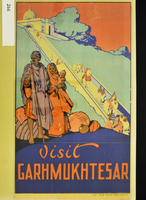 Visit Garhmunkhtesar
Visit Garhmunkhtesar This image of Garhmunkhtesar starts in the foreground with an image of what looks to be a family in the bottom left corner of the image. There is a man, woman, and child. The man, dressed in a mid-thigh length red under-garment and draped in purple cloth, looks to the left away from the woman and child. He wears a purple turban and holds a walking stick taller than he is. The wife standing to his right is draped in red fabric that covers her whole body including her head, nothing but her face, arms, and toes are seen. In the woman's arms in a small child dressed in a pink outfit with short sleeves and a hood. The woman and child both wear blue bangles. The woman wears hers around her wrist and the child wears theirs around their ankle. Around the feet of the family are what look to be large rocks, one with a cloth laid over it, and a small brown jug sitting on the ground. In the distance, behind the family there is a steep hill. There is a long white staircase on the hill that leads to the top where a white mosque sits, nestled by a large tree in full bloom. On the long staircase leading to the mosque there are 25 people, at the very base of the stairs there are four woman walking towards the family and the top of the stairs in front of the mosque are five people. This image seems to be a depiction of locals making a trek to an area mosque of some importance. Garhmunkhtesar at the time this poster was made was a part of the Garhwal District of British India and though the image does not depict a specific mosque from the area it does give a sense of what the area may have been like when religion and social gatherings were at the center of important social activities. The artist used soft inviting colors that create a serene motif. The soft salmon sky almost makes the scene look like it could be happening at the cusp of the afternoon just as the sun begins to set. These soft colors and the smiling faces of temple visitors create a wonderful lure for viewers.
-
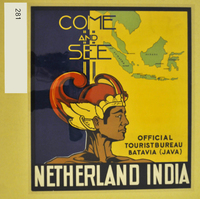 Come and See Netherland India
Come and See Netherland India At the very foreground of this image, that temps viewers to come see Netherland India, is a person seen from the collarbone up. Their skin is dark, and their hair is black, though most of it is hidden under an ornate red and gold headdress. The person's head is turned so the viewer can only see the profile of the left side of his face. Behind the person the image is broken into two colors. On the left side, for one third of the image the background is a deep blue. The remaining two thirds of the image is a marigold with a map of Netherland India over-layed on top of it. The map shows Sumatra, Borneo, Java, Bali, and Celebes. These islands are a light green and sit on the upper half of the marigold portion of the image. This image, though very simple in its graphic elements, does require some explanation. For example, when the poster refers to Netherland India what it is actually speaking about is Indonesia. Indonesia is the collection of smaller islands that are located in the Indian Ocean. Though the image describes them as the southern part of India, the countries shown in this image are actually located closer to Malaysia, Vietnam, and the Philippines. The other part of this image that is slightly confusing is the depiction of a person in the foreground. This person seems rather masculine with their sideburns, muscular neck, strong shoulders, and deep collarbone definition. It also looks as if this person is not wearing a shirt. All of these things may lead a viewer to believe that this person is male but the headdress they are wearing would suggest otherwise. The head covering looks very similar to an Indonesian Sumatra bride crown, an ornate metal crown that brides in Sumatra would adorn on their wedding day. This graphic yet somewhat ambiguous image creates a sense of strength and fervor as well as mystery about the islands of Indonesia, drawing viewers in and causing intrigue.
-
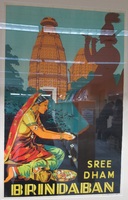 Sree Dham Brindaban
Sree Dham Brindaban The sky is a solid blue, in which stands two large Hindu temple towers. The temple is located in one of the most holy of Hindu pilgrimage sites, Sri Vrindavan Dham (spelled on the poster “Sree Dham Brindaban”). Obscuring the lower part of the temple is a thick, dark green treeline. In the foreground, a Hindu woman kneels while dropping flowers and fruit into an offering tray; a daily ritual called canang sari. She is dressed in colorful clothes, a garb made of red, yellow, and green cloth with flower patterns on it. She is barefoot, wears large gold earrings and multiple gold bracelets. To her right is a dark brown silhouette. The silhouette appears to be playing a woodwind instrument, likely a venu or bansuri. It is also wearing a hat of unclear make, with fibered frond-like ornamentation. The beautiful colors of the woman’s clothes and the celebratory poise of the instrument player paints Sri Vrindavan Dham as a place of wonder and majesty. Even the temple in the background seems to play on the viewer’s curiosity of foreign culture and art.This image depicting life and events in India is dripping in Indian religious heritage and culture. The woman making an offering at the foreground of the image kneels in front of the silhouette playing the instrument described as a venu or bansuri. the offering of fruit and flowers represents the plethora of nectorous fruit and aromatic foliage that the Vrindavan temple gardens produce. The silhouette is most likely that of a statue of Krishna, one of the most well known and highly worshiped Hindu deities. Krishna is known in many ways and many forms. He is recognized by the Hindu religion as the eighth incarnation of Vishnu and is very powerful and influential. Krishna is usually seen as a young boy either with his pet cow or playing his murali (flute). Krishna is not only specific to Indian religion but his history is directly connected to Sri Vrindavan Dham. This temple is believed to be the site at which Krishna was originated and spent much of his childhood life. The city of Vrindavan seemed to have lost its native importance during the 15th century but at the beginning of the 16th century it is said that religious teacher Chaitanya Mahaprabhu revalidated its significance through his journey to find the places in which Sri Krishna traveled and spent his time. Ever since Vrindavan has been considered one of the holiest sites in all of India and is known around the world for its cultural heritage and beauty. Still today there are festivals devoted to Chaitanya Mahaprabhu and his zealous work related to Krishna.
-
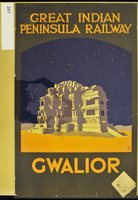 Gwalior
Great Indian Peninsula Railway
Gwalior
Great Indian Peninsula Railway Featuring mustard colored text superimposed upon an olive border, this poster adheres to a very basic color palette. A background of deep navy sky, dappled with stars overlooks a mustard desert with what appears to be mountains looming in the distance. A three-quarter view of a large, ancient structure dominates the center of the poster. The structure has distinct shadows and illuminated areas, despite lacking a pictured light source.
Gwalior is a historic city located in the Indian state of Madhya Pradesh (MP), about 322 km South from the Indian capital city of Delhi. Gwalior occupies a strategic location in the Gird region of India; the city and its fortress has been ruled under several historic northern Indian kingdoms. From the Tomars in the 13th century, it was passed on to the Mughals, then to the Marathas (1754) followed by the Scindias in 18th century.
The structure pictured in this poster is that of the Sas-bahu Temple, located to the east of Gwalior Fort. The simple label of "Gwalior" is very misleading as there exists a plethora of similarly structured buildings and historical structures within the city of Gwalior. Built in 1092 by King Mahipala of the Kachchhapaghata (Kachchhwaha) dynasty, this temple is one of the greatest architectural marvels situated by Gwalior Fort. It is 32 metres long and 22 metres at its breadth. This temple has three main entrances from three different directions. In the fourth direction, there is a room which is currently closed. The entire temple is covered with carvings, notably 4 idols of Brahma, Vishnu and Saraswati above its entrance door. As limestone erodes over time, soon portions fell away, spurring conflict as to whether it was a Jain temple or a Hindu temple.
The temple is on the Archaeological Survey of India's list of heritage monuments.
The site is very easily accessible by road, only 22 km from the tourist hot-spot of Udaipur. For those familiar with the area, the site is only 2.7 km from the well frequented Shaivite shrine of Eklingji.
-
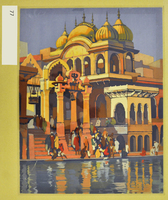 [Mosque, India]
[Mosque, India] There are several men, women, and children gathered near the edge of a water source. There are a set of stairs that the people congregate and relax on. A large decorative building colored orange, yellow, and red rests behind the people. There are large arch ways on the perimeter of the building and large and small sized pointed domes on top. There are also two bells hanging on the arch ways over the steps, leading down to the water-side. These people appear to be along the waterside of a mosque set in India. They could be gathering for religious ceremonies or for social encounters. It is not clear where and why they have come to this spot outside of the mosque.
-
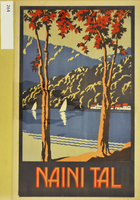 Naini Tal
Naini Tal Light blue skies with three sets of hills. The farthest hills are a darker blue color and the closest hill is brown colored. At the bottom of the closest hill are small white houses with red roofs. The houses sit on a body of water. On the water are two white sailboats and the white sails reflect off the water. In the foreground are two skinny trees with red leaves that sit on a piece of land. Naini Tal is a Himalayan resort town in the Kumaon region of India’s Uttarakhand state. It’s set around Nainital Lake, a popular boating site. The boaters are most likely tourists enjoying the lake and the red foliage surrounding them.Nainital Lake was a hidden gem, tucked away in the forest of the small Nainital province. This lake is the settlement and tourist attraction it is today do to happenstance. Nainital Lake was stumbled upon by British sugar salesman, P. Barron, and, due to his fascination with the site, soon became a British settlement. Previous to Mr. Barron's discovery the lake had been visited by other British vacationers but had not been made a settlement. Though this is why Nainital is so popular today for tourists the roots of this beautiful spot in Indian nature are rich with mythological stories and local religious folklore. The natives on Nainital were and are today a superstitious culture who follow traditions that have been around for hundreds of years. The Nainital people, mostly Hindu, worship many Gods and Goddesses today, thanking them for the peace and prosperity there region has attained. This culture is much different from its city counterparts and almost all social activity is linked to religious worship or activity.
-
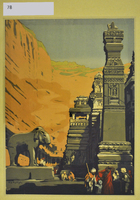 Indian Cave Temple
Indian Cave Temple Blue skies with shadows showing that it is a sunny day. There are orange stone walls surrounding grey stone structures that have carvings. There are several arches lining the stone walls. In front of the arches on the left side is an elephant sculpture with a broken nose. In front of the stone structures, with carvings, on the right side are eleven local people. There are two people in the far back that are unrecognizable. There is a man sitting by the elephant sculpture; to the right of the man are two people sitting on stairs in front of a structure. These two people are wearing what would be considered the proper clothing of the area which are long dresses or pants with cloth wrapped around their head. There is a group of people standing in front of the closest structure. There are six people. A dark skinned man with a white turban and white clothing along with orange fabric wrapped around his neck. He is also holding a stick in his right hand. This man is looking down at a child in blue clothing who is grabbing at the mans arm. There is a dark skinned woman in red clothing next to the man and child. There are three other people next to the woman and one of them is a man holding a stick in his left hand. The place in the poster is part of the Ellora caves and this is the Kailash Monolithic Temple. The structure was excavated out of the vertical face of a hill. They are Buddhist, Hindu and Jain cave temples and monasteries and were built between the 5th century and 10th century. This is a place where locals, like the ones in the poster, go to view the magnificent structures that are part of their culture.The Kailash Monolish Temple found in the Ellora Caves of the Sahyadri Hills region is considered one of the most curious and magnificent creations of rock - cut structures in the world. The caves in Maharashtra are 2 kilometers (1.24 miles) in length and include 34 different caves. Since the excavation of structures this site has become a major local and tourist attraction. Visitors can walk through the caves and the temples and monasteries that are constructed inside them. Within the caves there are thousands of rock sculptures and glyphs all of which must have been hand carved. Many of the sculptures are riddled with history and religious significance, luckily Dr. Deepanjana Klein and Dr. Arno Klein have done extensive work to document and transcribe information about the different aspects of the caves. These caves are a national monument for India, they drew people there with their magnificence and wonder a century ago and still do today.
-
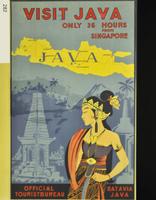 Visit Java
Only 36 hours from Singapore
Visit Java
Only 36 hours from Singapore In the foreground is a woman with long black hair dressed in what appears to be stereotypical Indonesian formal wear, including a gold headdress and red sash. Her head is turned to the side and her hand rests on her hip. In the background is the Indonesian landscape in blue. This consists of small temples, a dark jungle, and a large volcano (likely Krakatoa) looming in the distance. Above this scene is a yellow map of the island of Java, with important cities marked by dots. At the very top of the poster are the words: "Visit Java: Only 36 hours away from Singapore." This poster, especially its portrayal of an Indonesian woman, is representative of the exoticism of Eastern countries by Western audiences and visitors.This image depicting the world of Java from its geographical elements to its people, though enticing to westerners as an exotic world is not completely accurate. The main focus of this image, the woman standing in the foreground, is clad in an elaborate and very distinctive dress. This dress, with strapless top, center band, and over the shoulder shawl is a much more accurate representation of the traditional Thai wedding dress, not that of Java. The traditional attire of Javanese women is the Kebaya. This dress is believed to have been around since the 15th or 16th century and is still an important part of the Javanese culture today. Though the Kebaya has stood the test fo time and still is worn today over the centuries its meaning and symbolism has changed. Previous to the early 20th century the Kebaya was simply a symbol of tradition and femininity. This all changed with the life of one Indonesian woman, Raden A. Kartini. Raden was born into a world of tradition and inequality and through education and fervor for her own rights she founded the first Indonesian primary school for native girls that was not discriminatory based on social stats and that was also based in a more western style curriculum. Raden changed the identity of the Kebaya because though she was deeply rooted in her tradition she was also a strong feminist. Today Javanese women where the Kebaya with pride for their culture as well as their power.
-
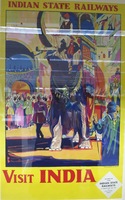 Visit India
Visit India There is a large ornate elephant that dominates the center of the poster. The trunk of the elephant is raised with the tusks decorated along with long robes and necklaces adorned around the sides and front of the body. On top of the elephant, there is an extravagant howdah with a Sheikh riding on top of the elephant. There appears to be several other Sheikhs surrounding the street observing the parade. Both the elephant's and audience's clothing are extremely colorful and vibrant. Behind the individuals and the animals, there are softly colored buildings with rounded archways that also have some decorations falling from their structure. The outside boarder of the poster is a bright yellow and says "Visit India" and "Indian State Railways". This poster exemplifies a procession in India with a mahout riding on an extravagantly decorated elephant. These dressings, colors, and decorations could be a procession within a celebration of the culture. There are many holidays celebrated in India every year, especially in Sikhism belief. This could be a Sikh holiday considering that almost all of the men in the scene are wearing a turban.
-
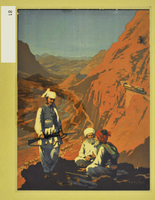 [Mountain Landscape with Three Indian Figures]
[Mountain Landscape with Three Indian Figures] Without text on the page, this poster depicts three men possibly Indian surrounded by red mountains, a river, a herd of camels and a train. Vast red mountains spanning far into the distance, reach all the way up to a bright blue sky. Ledges cut in to the side allow transportation of trains, camels and people. In the foreground, three men are dressed in cultural clothing including two white turbans and one red turban. One man is standing with a gun in a vest while two are sitting by the cliffs edge. This poster does not exhibit a title or date; however, it can be surmised that the travel agency is enticing visitors to travel to India. The train in which tourists will travel is painted in the background. India depicted in the poster exudes exoticism and mystery that could attract potential tourists.Though this image has no text it may very well be an advertisement for the Mountain Railways of India. This set of railways, thee in all, travel through major mountain ranges in India: the Himalayas in West Bengal, the Nilgiri Hills of Tamil Nadu, and the Himalayan Foothills of Himachal Pradesh. The development of these railways from 1881 to 1908 had a serious impact on India as a country "The development of railways in the 19th century had a profound influence on social and economic developments in many parts of the world...The Mountain Railways of India are outstanding examples of how access has been provided to the plains and plateaus of the Indian mountains" (unesco.org).All three of these railways are still operational today, they do face occasional standstills due to weather creating required maintenance on the tracks but the these railways have become an iconic part of India, drawing in tourist from around the world. These trains provide "unmatched travel adventure in rugged mountainous terrain" (National Geographic). These railways have brought access to locals and tourists alike, created revenue for all cities along the railways, and are a true display of technological advancements that have stood the test of time. Though more stops have been added since their development these routes such as the DHR route have been the same for over a century.
-
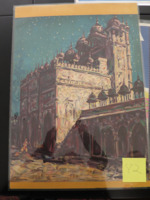 [See India]
[See India] Marigold border on top and bottom. The background is a blue-grey with stars in the background. In the foreground is a side view of an Indian mosque that looks like an impressionist painting. There is a person walking near one of the arches of the temple with a walking stick in their left hand. The mosque in this image looks as if it was a depiction inspired by the Jama Masjid located in New Delhi, India. This mosque is a place of prayer and the person in the poster is making their way to the mosque during a time of prayer. In researching this poster I found that this poster had been cut, taking off a part of the poster that lists the location Fatepur Sikri and says See India in large text.The Jama Masjid was designed and commissioned by Mughal Emperor Shah Jahan in 1656. This extravagant work of architecture was and still is today the largest mosque in India. Jama Masjid is also known as 'Masjid-i-Jahanuma' or 'Mosque commanding view of the world' which it indeed does through its extensive use of beautiful marble, towering minarets, and massive arches.Jama Masjid was built as the Emperor Shah Jahan's principle mosque and is said to exude the religious vehemence of the Mughal Empire but a poem written in 1925 by Grace H. Ruthenburg, a U.S. poet, may suggest otherwise. Shah Jahan Built a Sepulchre recounts the creation of a palace for a woman he loved but acted more as a tomb trapping her from what she truly loved. This poem speaks of a building with turrets piercing the air, ivory towers with marble leaf, and azur balustrade which sounds very similar to the Jama Masjid. Though there is no historical backing that states the Jama Masjid was built for a lover of Shah Jahan, this poem does tell a lovely yet dark story that shows the architectures presence and reach to far off countries.
 Visit Garhmunkhtesar This image of Garhmunkhtesar starts in the foreground with an image of what looks to be a family in the bottom left corner of the image. There is a man, woman, and child. The man, dressed in a mid-thigh length red under-garment and draped in purple cloth, looks to the left away from the woman and child. He wears a purple turban and holds a walking stick taller than he is. The wife standing to his right is draped in red fabric that covers her whole body including her head, nothing but her face, arms, and toes are seen. In the woman's arms in a small child dressed in a pink outfit with short sleeves and a hood. The woman and child both wear blue bangles. The woman wears hers around her wrist and the child wears theirs around their ankle. Around the feet of the family are what look to be large rocks, one with a cloth laid over it, and a small brown jug sitting on the ground. In the distance, behind the family there is a steep hill. There is a long white staircase on the hill that leads to the top where a white mosque sits, nestled by a large tree in full bloom. On the long staircase leading to the mosque there are 25 people, at the very base of the stairs there are four woman walking towards the family and the top of the stairs in front of the mosque are five people. This image seems to be a depiction of locals making a trek to an area mosque of some importance. Garhmunkhtesar at the time this poster was made was a part of the Garhwal District of British India and though the image does not depict a specific mosque from the area it does give a sense of what the area may have been like when religion and social gatherings were at the center of important social activities. The artist used soft inviting colors that create a serene motif. The soft salmon sky almost makes the scene look like it could be happening at the cusp of the afternoon just as the sun begins to set. These soft colors and the smiling faces of temple visitors create a wonderful lure for viewers.
Visit Garhmunkhtesar This image of Garhmunkhtesar starts in the foreground with an image of what looks to be a family in the bottom left corner of the image. There is a man, woman, and child. The man, dressed in a mid-thigh length red under-garment and draped in purple cloth, looks to the left away from the woman and child. He wears a purple turban and holds a walking stick taller than he is. The wife standing to his right is draped in red fabric that covers her whole body including her head, nothing but her face, arms, and toes are seen. In the woman's arms in a small child dressed in a pink outfit with short sleeves and a hood. The woman and child both wear blue bangles. The woman wears hers around her wrist and the child wears theirs around their ankle. Around the feet of the family are what look to be large rocks, one with a cloth laid over it, and a small brown jug sitting on the ground. In the distance, behind the family there is a steep hill. There is a long white staircase on the hill that leads to the top where a white mosque sits, nestled by a large tree in full bloom. On the long staircase leading to the mosque there are 25 people, at the very base of the stairs there are four woman walking towards the family and the top of the stairs in front of the mosque are five people. This image seems to be a depiction of locals making a trek to an area mosque of some importance. Garhmunkhtesar at the time this poster was made was a part of the Garhwal District of British India and though the image does not depict a specific mosque from the area it does give a sense of what the area may have been like when religion and social gatherings were at the center of important social activities. The artist used soft inviting colors that create a serene motif. The soft salmon sky almost makes the scene look like it could be happening at the cusp of the afternoon just as the sun begins to set. These soft colors and the smiling faces of temple visitors create a wonderful lure for viewers. Come and See Netherland India At the very foreground of this image, that temps viewers to come see Netherland India, is a person seen from the collarbone up. Their skin is dark, and their hair is black, though most of it is hidden under an ornate red and gold headdress. The person's head is turned so the viewer can only see the profile of the left side of his face. Behind the person the image is broken into two colors. On the left side, for one third of the image the background is a deep blue. The remaining two thirds of the image is a marigold with a map of Netherland India over-layed on top of it. The map shows Sumatra, Borneo, Java, Bali, and Celebes. These islands are a light green and sit on the upper half of the marigold portion of the image. This image, though very simple in its graphic elements, does require some explanation. For example, when the poster refers to Netherland India what it is actually speaking about is Indonesia. Indonesia is the collection of smaller islands that are located in the Indian Ocean. Though the image describes them as the southern part of India, the countries shown in this image are actually located closer to Malaysia, Vietnam, and the Philippines. The other part of this image that is slightly confusing is the depiction of a person in the foreground. This person seems rather masculine with their sideburns, muscular neck, strong shoulders, and deep collarbone definition. It also looks as if this person is not wearing a shirt. All of these things may lead a viewer to believe that this person is male but the headdress they are wearing would suggest otherwise. The head covering looks very similar to an Indonesian Sumatra bride crown, an ornate metal crown that brides in Sumatra would adorn on their wedding day. This graphic yet somewhat ambiguous image creates a sense of strength and fervor as well as mystery about the islands of Indonesia, drawing viewers in and causing intrigue.
Come and See Netherland India At the very foreground of this image, that temps viewers to come see Netherland India, is a person seen from the collarbone up. Their skin is dark, and their hair is black, though most of it is hidden under an ornate red and gold headdress. The person's head is turned so the viewer can only see the profile of the left side of his face. Behind the person the image is broken into two colors. On the left side, for one third of the image the background is a deep blue. The remaining two thirds of the image is a marigold with a map of Netherland India over-layed on top of it. The map shows Sumatra, Borneo, Java, Bali, and Celebes. These islands are a light green and sit on the upper half of the marigold portion of the image. This image, though very simple in its graphic elements, does require some explanation. For example, when the poster refers to Netherland India what it is actually speaking about is Indonesia. Indonesia is the collection of smaller islands that are located in the Indian Ocean. Though the image describes them as the southern part of India, the countries shown in this image are actually located closer to Malaysia, Vietnam, and the Philippines. The other part of this image that is slightly confusing is the depiction of a person in the foreground. This person seems rather masculine with their sideburns, muscular neck, strong shoulders, and deep collarbone definition. It also looks as if this person is not wearing a shirt. All of these things may lead a viewer to believe that this person is male but the headdress they are wearing would suggest otherwise. The head covering looks very similar to an Indonesian Sumatra bride crown, an ornate metal crown that brides in Sumatra would adorn on their wedding day. This graphic yet somewhat ambiguous image creates a sense of strength and fervor as well as mystery about the islands of Indonesia, drawing viewers in and causing intrigue. Sree Dham Brindaban The sky is a solid blue, in which stands two large Hindu temple towers. The temple is located in one of the most holy of Hindu pilgrimage sites, Sri Vrindavan Dham (spelled on the poster “Sree Dham Brindaban”). Obscuring the lower part of the temple is a thick, dark green treeline. In the foreground, a Hindu woman kneels while dropping flowers and fruit into an offering tray; a daily ritual called canang sari. She is dressed in colorful clothes, a garb made of red, yellow, and green cloth with flower patterns on it. She is barefoot, wears large gold earrings and multiple gold bracelets. To her right is a dark brown silhouette. The silhouette appears to be playing a woodwind instrument, likely a venu or bansuri. It is also wearing a hat of unclear make, with fibered frond-like ornamentation. The beautiful colors of the woman’s clothes and the celebratory poise of the instrument player paints Sri Vrindavan Dham as a place of wonder and majesty. Even the temple in the background seems to play on the viewer’s curiosity of foreign culture and art.This image depicting life and events in India is dripping in Indian religious heritage and culture. The woman making an offering at the foreground of the image kneels in front of the silhouette playing the instrument described as a venu or bansuri. the offering of fruit and flowers represents the plethora of nectorous fruit and aromatic foliage that the Vrindavan temple gardens produce. The silhouette is most likely that of a statue of Krishna, one of the most well known and highly worshiped Hindu deities. Krishna is known in many ways and many forms. He is recognized by the Hindu religion as the eighth incarnation of Vishnu and is very powerful and influential. Krishna is usually seen as a young boy either with his pet cow or playing his murali (flute). Krishna is not only specific to Indian religion but his history is directly connected to Sri Vrindavan Dham. This temple is believed to be the site at which Krishna was originated and spent much of his childhood life. The city of Vrindavan seemed to have lost its native importance during the 15th century but at the beginning of the 16th century it is said that religious teacher Chaitanya Mahaprabhu revalidated its significance through his journey to find the places in which Sri Krishna traveled and spent his time. Ever since Vrindavan has been considered one of the holiest sites in all of India and is known around the world for its cultural heritage and beauty. Still today there are festivals devoted to Chaitanya Mahaprabhu and his zealous work related to Krishna.
Sree Dham Brindaban The sky is a solid blue, in which stands two large Hindu temple towers. The temple is located in one of the most holy of Hindu pilgrimage sites, Sri Vrindavan Dham (spelled on the poster “Sree Dham Brindaban”). Obscuring the lower part of the temple is a thick, dark green treeline. In the foreground, a Hindu woman kneels while dropping flowers and fruit into an offering tray; a daily ritual called canang sari. She is dressed in colorful clothes, a garb made of red, yellow, and green cloth with flower patterns on it. She is barefoot, wears large gold earrings and multiple gold bracelets. To her right is a dark brown silhouette. The silhouette appears to be playing a woodwind instrument, likely a venu or bansuri. It is also wearing a hat of unclear make, with fibered frond-like ornamentation. The beautiful colors of the woman’s clothes and the celebratory poise of the instrument player paints Sri Vrindavan Dham as a place of wonder and majesty. Even the temple in the background seems to play on the viewer’s curiosity of foreign culture and art.This image depicting life and events in India is dripping in Indian religious heritage and culture. The woman making an offering at the foreground of the image kneels in front of the silhouette playing the instrument described as a venu or bansuri. the offering of fruit and flowers represents the plethora of nectorous fruit and aromatic foliage that the Vrindavan temple gardens produce. The silhouette is most likely that of a statue of Krishna, one of the most well known and highly worshiped Hindu deities. Krishna is known in many ways and many forms. He is recognized by the Hindu religion as the eighth incarnation of Vishnu and is very powerful and influential. Krishna is usually seen as a young boy either with his pet cow or playing his murali (flute). Krishna is not only specific to Indian religion but his history is directly connected to Sri Vrindavan Dham. This temple is believed to be the site at which Krishna was originated and spent much of his childhood life. The city of Vrindavan seemed to have lost its native importance during the 15th century but at the beginning of the 16th century it is said that religious teacher Chaitanya Mahaprabhu revalidated its significance through his journey to find the places in which Sri Krishna traveled and spent his time. Ever since Vrindavan has been considered one of the holiest sites in all of India and is known around the world for its cultural heritage and beauty. Still today there are festivals devoted to Chaitanya Mahaprabhu and his zealous work related to Krishna. Gwalior
Great Indian Peninsula Railway Featuring mustard colored text superimposed upon an olive border, this poster adheres to a very basic color palette. A background of deep navy sky, dappled with stars overlooks a mustard desert with what appears to be mountains looming in the distance. A three-quarter view of a large, ancient structure dominates the center of the poster. The structure has distinct shadows and illuminated areas, despite lacking a pictured light source. Gwalior is a historic city located in the Indian state of Madhya Pradesh (MP), about 322 km South from the Indian capital city of Delhi. Gwalior occupies a strategic location in the Gird region of India; the city and its fortress has been ruled under several historic northern Indian kingdoms. From the Tomars in the 13th century, it was passed on to the Mughals, then to the Marathas (1754) followed by the Scindias in 18th century. The structure pictured in this poster is that of the Sas-bahu Temple, located to the east of Gwalior Fort. The simple label of "Gwalior" is very misleading as there exists a plethora of similarly structured buildings and historical structures within the city of Gwalior. Built in 1092 by King Mahipala of the Kachchhapaghata (Kachchhwaha) dynasty, this temple is one of the greatest architectural marvels situated by Gwalior Fort. It is 32 metres long and 22 metres at its breadth. This temple has three main entrances from three different directions. In the fourth direction, there is a room which is currently closed. The entire temple is covered with carvings, notably 4 idols of Brahma, Vishnu and Saraswati above its entrance door. As limestone erodes over time, soon portions fell away, spurring conflict as to whether it was a Jain temple or a Hindu temple. The temple is on the Archaeological Survey of India's list of heritage monuments. The site is very easily accessible by road, only 22 km from the tourist hot-spot of Udaipur. For those familiar with the area, the site is only 2.7 km from the well frequented Shaivite shrine of Eklingji.
Gwalior
Great Indian Peninsula Railway Featuring mustard colored text superimposed upon an olive border, this poster adheres to a very basic color palette. A background of deep navy sky, dappled with stars overlooks a mustard desert with what appears to be mountains looming in the distance. A three-quarter view of a large, ancient structure dominates the center of the poster. The structure has distinct shadows and illuminated areas, despite lacking a pictured light source. Gwalior is a historic city located in the Indian state of Madhya Pradesh (MP), about 322 km South from the Indian capital city of Delhi. Gwalior occupies a strategic location in the Gird region of India; the city and its fortress has been ruled under several historic northern Indian kingdoms. From the Tomars in the 13th century, it was passed on to the Mughals, then to the Marathas (1754) followed by the Scindias in 18th century. The structure pictured in this poster is that of the Sas-bahu Temple, located to the east of Gwalior Fort. The simple label of "Gwalior" is very misleading as there exists a plethora of similarly structured buildings and historical structures within the city of Gwalior. Built in 1092 by King Mahipala of the Kachchhapaghata (Kachchhwaha) dynasty, this temple is one of the greatest architectural marvels situated by Gwalior Fort. It is 32 metres long and 22 metres at its breadth. This temple has three main entrances from three different directions. In the fourth direction, there is a room which is currently closed. The entire temple is covered with carvings, notably 4 idols of Brahma, Vishnu and Saraswati above its entrance door. As limestone erodes over time, soon portions fell away, spurring conflict as to whether it was a Jain temple or a Hindu temple. The temple is on the Archaeological Survey of India's list of heritage monuments. The site is very easily accessible by road, only 22 km from the tourist hot-spot of Udaipur. For those familiar with the area, the site is only 2.7 km from the well frequented Shaivite shrine of Eklingji. [Mosque, India] There are several men, women, and children gathered near the edge of a water source. There are a set of stairs that the people congregate and relax on. A large decorative building colored orange, yellow, and red rests behind the people. There are large arch ways on the perimeter of the building and large and small sized pointed domes on top. There are also two bells hanging on the arch ways over the steps, leading down to the water-side. These people appear to be along the waterside of a mosque set in India. They could be gathering for religious ceremonies or for social encounters. It is not clear where and why they have come to this spot outside of the mosque.
[Mosque, India] There are several men, women, and children gathered near the edge of a water source. There are a set of stairs that the people congregate and relax on. A large decorative building colored orange, yellow, and red rests behind the people. There are large arch ways on the perimeter of the building and large and small sized pointed domes on top. There are also two bells hanging on the arch ways over the steps, leading down to the water-side. These people appear to be along the waterside of a mosque set in India. They could be gathering for religious ceremonies or for social encounters. It is not clear where and why they have come to this spot outside of the mosque. Naini Tal Light blue skies with three sets of hills. The farthest hills are a darker blue color and the closest hill is brown colored. At the bottom of the closest hill are small white houses with red roofs. The houses sit on a body of water. On the water are two white sailboats and the white sails reflect off the water. In the foreground are two skinny trees with red leaves that sit on a piece of land. Naini Tal is a Himalayan resort town in the Kumaon region of India’s Uttarakhand state. It’s set around Nainital Lake, a popular boating site. The boaters are most likely tourists enjoying the lake and the red foliage surrounding them.Nainital Lake was a hidden gem, tucked away in the forest of the small Nainital province. This lake is the settlement and tourist attraction it is today do to happenstance. Nainital Lake was stumbled upon by British sugar salesman, P. Barron, and, due to his fascination with the site, soon became a British settlement. Previous to Mr. Barron's discovery the lake had been visited by other British vacationers but had not been made a settlement. Though this is why Nainital is so popular today for tourists the roots of this beautiful spot in Indian nature are rich with mythological stories and local religious folklore. The natives on Nainital were and are today a superstitious culture who follow traditions that have been around for hundreds of years. The Nainital people, mostly Hindu, worship many Gods and Goddesses today, thanking them for the peace and prosperity there region has attained. This culture is much different from its city counterparts and almost all social activity is linked to religious worship or activity.
Naini Tal Light blue skies with three sets of hills. The farthest hills are a darker blue color and the closest hill is brown colored. At the bottom of the closest hill are small white houses with red roofs. The houses sit on a body of water. On the water are two white sailboats and the white sails reflect off the water. In the foreground are two skinny trees with red leaves that sit on a piece of land. Naini Tal is a Himalayan resort town in the Kumaon region of India’s Uttarakhand state. It’s set around Nainital Lake, a popular boating site. The boaters are most likely tourists enjoying the lake and the red foliage surrounding them.Nainital Lake was a hidden gem, tucked away in the forest of the small Nainital province. This lake is the settlement and tourist attraction it is today do to happenstance. Nainital Lake was stumbled upon by British sugar salesman, P. Barron, and, due to his fascination with the site, soon became a British settlement. Previous to Mr. Barron's discovery the lake had been visited by other British vacationers but had not been made a settlement. Though this is why Nainital is so popular today for tourists the roots of this beautiful spot in Indian nature are rich with mythological stories and local religious folklore. The natives on Nainital were and are today a superstitious culture who follow traditions that have been around for hundreds of years. The Nainital people, mostly Hindu, worship many Gods and Goddesses today, thanking them for the peace and prosperity there region has attained. This culture is much different from its city counterparts and almost all social activity is linked to religious worship or activity. Indian Cave Temple Blue skies with shadows showing that it is a sunny day. There are orange stone walls surrounding grey stone structures that have carvings. There are several arches lining the stone walls. In front of the arches on the left side is an elephant sculpture with a broken nose. In front of the stone structures, with carvings, on the right side are eleven local people. There are two people in the far back that are unrecognizable. There is a man sitting by the elephant sculpture; to the right of the man are two people sitting on stairs in front of a structure. These two people are wearing what would be considered the proper clothing of the area which are long dresses or pants with cloth wrapped around their head. There is a group of people standing in front of the closest structure. There are six people. A dark skinned man with a white turban and white clothing along with orange fabric wrapped around his neck. He is also holding a stick in his right hand. This man is looking down at a child in blue clothing who is grabbing at the mans arm. There is a dark skinned woman in red clothing next to the man and child. There are three other people next to the woman and one of them is a man holding a stick in his left hand. The place in the poster is part of the Ellora caves and this is the Kailash Monolithic Temple. The structure was excavated out of the vertical face of a hill. They are Buddhist, Hindu and Jain cave temples and monasteries and were built between the 5th century and 10th century. This is a place where locals, like the ones in the poster, go to view the magnificent structures that are part of their culture.The Kailash Monolish Temple found in the Ellora Caves of the Sahyadri Hills region is considered one of the most curious and magnificent creations of rock - cut structures in the world. The caves in Maharashtra are 2 kilometers (1.24 miles) in length and include 34 different caves. Since the excavation of structures this site has become a major local and tourist attraction. Visitors can walk through the caves and the temples and monasteries that are constructed inside them. Within the caves there are thousands of rock sculptures and glyphs all of which must have been hand carved. Many of the sculptures are riddled with history and religious significance, luckily Dr. Deepanjana Klein and Dr. Arno Klein have done extensive work to document and transcribe information about the different aspects of the caves. These caves are a national monument for India, they drew people there with their magnificence and wonder a century ago and still do today.
Indian Cave Temple Blue skies with shadows showing that it is a sunny day. There are orange stone walls surrounding grey stone structures that have carvings. There are several arches lining the stone walls. In front of the arches on the left side is an elephant sculpture with a broken nose. In front of the stone structures, with carvings, on the right side are eleven local people. There are two people in the far back that are unrecognizable. There is a man sitting by the elephant sculpture; to the right of the man are two people sitting on stairs in front of a structure. These two people are wearing what would be considered the proper clothing of the area which are long dresses or pants with cloth wrapped around their head. There is a group of people standing in front of the closest structure. There are six people. A dark skinned man with a white turban and white clothing along with orange fabric wrapped around his neck. He is also holding a stick in his right hand. This man is looking down at a child in blue clothing who is grabbing at the mans arm. There is a dark skinned woman in red clothing next to the man and child. There are three other people next to the woman and one of them is a man holding a stick in his left hand. The place in the poster is part of the Ellora caves and this is the Kailash Monolithic Temple. The structure was excavated out of the vertical face of a hill. They are Buddhist, Hindu and Jain cave temples and monasteries and were built between the 5th century and 10th century. This is a place where locals, like the ones in the poster, go to view the magnificent structures that are part of their culture.The Kailash Monolish Temple found in the Ellora Caves of the Sahyadri Hills region is considered one of the most curious and magnificent creations of rock - cut structures in the world. The caves in Maharashtra are 2 kilometers (1.24 miles) in length and include 34 different caves. Since the excavation of structures this site has become a major local and tourist attraction. Visitors can walk through the caves and the temples and monasteries that are constructed inside them. Within the caves there are thousands of rock sculptures and glyphs all of which must have been hand carved. Many of the sculptures are riddled with history and religious significance, luckily Dr. Deepanjana Klein and Dr. Arno Klein have done extensive work to document and transcribe information about the different aspects of the caves. These caves are a national monument for India, they drew people there with their magnificence and wonder a century ago and still do today. Visit Java
Only 36 hours from Singapore In the foreground is a woman with long black hair dressed in what appears to be stereotypical Indonesian formal wear, including a gold headdress and red sash. Her head is turned to the side and her hand rests on her hip. In the background is the Indonesian landscape in blue. This consists of small temples, a dark jungle, and a large volcano (likely Krakatoa) looming in the distance. Above this scene is a yellow map of the island of Java, with important cities marked by dots. At the very top of the poster are the words: "Visit Java: Only 36 hours away from Singapore." This poster, especially its portrayal of an Indonesian woman, is representative of the exoticism of Eastern countries by Western audiences and visitors.This image depicting the world of Java from its geographical elements to its people, though enticing to westerners as an exotic world is not completely accurate. The main focus of this image, the woman standing in the foreground, is clad in an elaborate and very distinctive dress. This dress, with strapless top, center band, and over the shoulder shawl is a much more accurate representation of the traditional Thai wedding dress, not that of Java. The traditional attire of Javanese women is the Kebaya. This dress is believed to have been around since the 15th or 16th century and is still an important part of the Javanese culture today. Though the Kebaya has stood the test fo time and still is worn today over the centuries its meaning and symbolism has changed. Previous to the early 20th century the Kebaya was simply a symbol of tradition and femininity. This all changed with the life of one Indonesian woman, Raden A. Kartini. Raden was born into a world of tradition and inequality and through education and fervor for her own rights she founded the first Indonesian primary school for native girls that was not discriminatory based on social stats and that was also based in a more western style curriculum. Raden changed the identity of the Kebaya because though she was deeply rooted in her tradition she was also a strong feminist. Today Javanese women where the Kebaya with pride for their culture as well as their power.
Visit Java
Only 36 hours from Singapore In the foreground is a woman with long black hair dressed in what appears to be stereotypical Indonesian formal wear, including a gold headdress and red sash. Her head is turned to the side and her hand rests on her hip. In the background is the Indonesian landscape in blue. This consists of small temples, a dark jungle, and a large volcano (likely Krakatoa) looming in the distance. Above this scene is a yellow map of the island of Java, with important cities marked by dots. At the very top of the poster are the words: "Visit Java: Only 36 hours away from Singapore." This poster, especially its portrayal of an Indonesian woman, is representative of the exoticism of Eastern countries by Western audiences and visitors.This image depicting the world of Java from its geographical elements to its people, though enticing to westerners as an exotic world is not completely accurate. The main focus of this image, the woman standing in the foreground, is clad in an elaborate and very distinctive dress. This dress, with strapless top, center band, and over the shoulder shawl is a much more accurate representation of the traditional Thai wedding dress, not that of Java. The traditional attire of Javanese women is the Kebaya. This dress is believed to have been around since the 15th or 16th century and is still an important part of the Javanese culture today. Though the Kebaya has stood the test fo time and still is worn today over the centuries its meaning and symbolism has changed. Previous to the early 20th century the Kebaya was simply a symbol of tradition and femininity. This all changed with the life of one Indonesian woman, Raden A. Kartini. Raden was born into a world of tradition and inequality and through education and fervor for her own rights she founded the first Indonesian primary school for native girls that was not discriminatory based on social stats and that was also based in a more western style curriculum. Raden changed the identity of the Kebaya because though she was deeply rooted in her tradition she was also a strong feminist. Today Javanese women where the Kebaya with pride for their culture as well as their power. Visit India There is a large ornate elephant that dominates the center of the poster. The trunk of the elephant is raised with the tusks decorated along with long robes and necklaces adorned around the sides and front of the body. On top of the elephant, there is an extravagant howdah with a Sheikh riding on top of the elephant. There appears to be several other Sheikhs surrounding the street observing the parade. Both the elephant's and audience's clothing are extremely colorful and vibrant. Behind the individuals and the animals, there are softly colored buildings with rounded archways that also have some decorations falling from their structure. The outside boarder of the poster is a bright yellow and says "Visit India" and "Indian State Railways". This poster exemplifies a procession in India with a mahout riding on an extravagantly decorated elephant. These dressings, colors, and decorations could be a procession within a celebration of the culture. There are many holidays celebrated in India every year, especially in Sikhism belief. This could be a Sikh holiday considering that almost all of the men in the scene are wearing a turban.
Visit India There is a large ornate elephant that dominates the center of the poster. The trunk of the elephant is raised with the tusks decorated along with long robes and necklaces adorned around the sides and front of the body. On top of the elephant, there is an extravagant howdah with a Sheikh riding on top of the elephant. There appears to be several other Sheikhs surrounding the street observing the parade. Both the elephant's and audience's clothing are extremely colorful and vibrant. Behind the individuals and the animals, there are softly colored buildings with rounded archways that also have some decorations falling from their structure. The outside boarder of the poster is a bright yellow and says "Visit India" and "Indian State Railways". This poster exemplifies a procession in India with a mahout riding on an extravagantly decorated elephant. These dressings, colors, and decorations could be a procession within a celebration of the culture. There are many holidays celebrated in India every year, especially in Sikhism belief. This could be a Sikh holiday considering that almost all of the men in the scene are wearing a turban. [Mountain Landscape with Three Indian Figures] Without text on the page, this poster depicts three men possibly Indian surrounded by red mountains, a river, a herd of camels and a train. Vast red mountains spanning far into the distance, reach all the way up to a bright blue sky. Ledges cut in to the side allow transportation of trains, camels and people. In the foreground, three men are dressed in cultural clothing including two white turbans and one red turban. One man is standing with a gun in a vest while two are sitting by the cliffs edge. This poster does not exhibit a title or date; however, it can be surmised that the travel agency is enticing visitors to travel to India. The train in which tourists will travel is painted in the background. India depicted in the poster exudes exoticism and mystery that could attract potential tourists.Though this image has no text it may very well be an advertisement for the Mountain Railways of India. This set of railways, thee in all, travel through major mountain ranges in India: the Himalayas in West Bengal, the Nilgiri Hills of Tamil Nadu, and the Himalayan Foothills of Himachal Pradesh. The development of these railways from 1881 to 1908 had a serious impact on India as a country "The development of railways in the 19th century had a profound influence on social and economic developments in many parts of the world...The Mountain Railways of India are outstanding examples of how access has been provided to the plains and plateaus of the Indian mountains" (unesco.org).All three of these railways are still operational today, they do face occasional standstills due to weather creating required maintenance on the tracks but the these railways have become an iconic part of India, drawing in tourist from around the world. These trains provide "unmatched travel adventure in rugged mountainous terrain" (National Geographic). These railways have brought access to locals and tourists alike, created revenue for all cities along the railways, and are a true display of technological advancements that have stood the test of time. Though more stops have been added since their development these routes such as the DHR route have been the same for over a century.
[Mountain Landscape with Three Indian Figures] Without text on the page, this poster depicts three men possibly Indian surrounded by red mountains, a river, a herd of camels and a train. Vast red mountains spanning far into the distance, reach all the way up to a bright blue sky. Ledges cut in to the side allow transportation of trains, camels and people. In the foreground, three men are dressed in cultural clothing including two white turbans and one red turban. One man is standing with a gun in a vest while two are sitting by the cliffs edge. This poster does not exhibit a title or date; however, it can be surmised that the travel agency is enticing visitors to travel to India. The train in which tourists will travel is painted in the background. India depicted in the poster exudes exoticism and mystery that could attract potential tourists.Though this image has no text it may very well be an advertisement for the Mountain Railways of India. This set of railways, thee in all, travel through major mountain ranges in India: the Himalayas in West Bengal, the Nilgiri Hills of Tamil Nadu, and the Himalayan Foothills of Himachal Pradesh. The development of these railways from 1881 to 1908 had a serious impact on India as a country "The development of railways in the 19th century had a profound influence on social and economic developments in many parts of the world...The Mountain Railways of India are outstanding examples of how access has been provided to the plains and plateaus of the Indian mountains" (unesco.org).All three of these railways are still operational today, they do face occasional standstills due to weather creating required maintenance on the tracks but the these railways have become an iconic part of India, drawing in tourist from around the world. These trains provide "unmatched travel adventure in rugged mountainous terrain" (National Geographic). These railways have brought access to locals and tourists alike, created revenue for all cities along the railways, and are a true display of technological advancements that have stood the test of time. Though more stops have been added since their development these routes such as the DHR route have been the same for over a century. [See India] Marigold border on top and bottom. The background is a blue-grey with stars in the background. In the foreground is a side view of an Indian mosque that looks like an impressionist painting. There is a person walking near one of the arches of the temple with a walking stick in their left hand. The mosque in this image looks as if it was a depiction inspired by the Jama Masjid located in New Delhi, India. This mosque is a place of prayer and the person in the poster is making their way to the mosque during a time of prayer. In researching this poster I found that this poster had been cut, taking off a part of the poster that lists the location Fatepur Sikri and says See India in large text.The Jama Masjid was designed and commissioned by Mughal Emperor Shah Jahan in 1656. This extravagant work of architecture was and still is today the largest mosque in India. Jama Masjid is also known as 'Masjid-i-Jahanuma' or 'Mosque commanding view of the world' which it indeed does through its extensive use of beautiful marble, towering minarets, and massive arches.Jama Masjid was built as the Emperor Shah Jahan's principle mosque and is said to exude the religious vehemence of the Mughal Empire but a poem written in 1925 by Grace H. Ruthenburg, a U.S. poet, may suggest otherwise. Shah Jahan Built a Sepulchre recounts the creation of a palace for a woman he loved but acted more as a tomb trapping her from what she truly loved. This poem speaks of a building with turrets piercing the air, ivory towers with marble leaf, and azur balustrade which sounds very similar to the Jama Masjid. Though there is no historical backing that states the Jama Masjid was built for a lover of Shah Jahan, this poem does tell a lovely yet dark story that shows the architectures presence and reach to far off countries.
[See India] Marigold border on top and bottom. The background is a blue-grey with stars in the background. In the foreground is a side view of an Indian mosque that looks like an impressionist painting. There is a person walking near one of the arches of the temple with a walking stick in their left hand. The mosque in this image looks as if it was a depiction inspired by the Jama Masjid located in New Delhi, India. This mosque is a place of prayer and the person in the poster is making their way to the mosque during a time of prayer. In researching this poster I found that this poster had been cut, taking off a part of the poster that lists the location Fatepur Sikri and says See India in large text.The Jama Masjid was designed and commissioned by Mughal Emperor Shah Jahan in 1656. This extravagant work of architecture was and still is today the largest mosque in India. Jama Masjid is also known as 'Masjid-i-Jahanuma' or 'Mosque commanding view of the world' which it indeed does through its extensive use of beautiful marble, towering minarets, and massive arches.Jama Masjid was built as the Emperor Shah Jahan's principle mosque and is said to exude the religious vehemence of the Mughal Empire but a poem written in 1925 by Grace H. Ruthenburg, a U.S. poet, may suggest otherwise. Shah Jahan Built a Sepulchre recounts the creation of a palace for a woman he loved but acted more as a tomb trapping her from what she truly loved. This poem speaks of a building with turrets piercing the air, ivory towers with marble leaf, and azur balustrade which sounds very similar to the Jama Masjid. Though there is no historical backing that states the Jama Masjid was built for a lover of Shah Jahan, this poem does tell a lovely yet dark story that shows the architectures presence and reach to far off countries.